AURETB002: Analyzing and Evaluating Faults in Dynamic Control Systems
VerifiedAdded on 2023/04/21
|25
|7326
|453
Report
AI Summary
This report provides a comprehensive analysis and evaluation of electrical and electronic faults in dynamic control management systems (AURETB002). It covers objectives, specifications, system faults, hazard identification, evaluation criteria, and steps for analyzing faults in light vehicles. The report also details testing equipment, tools, dynamic control components, analytical methodologies, and the negative outcomes of improper testing. Verification methods, fault examples with fixes, diagnostic report usage, final inspection processes, safety and environmental requirements, tool maintenance, and the importance of workplace documentation are discussed, along with common engine faults and their causes. Desklib offers access to this report and many other solved assignments.
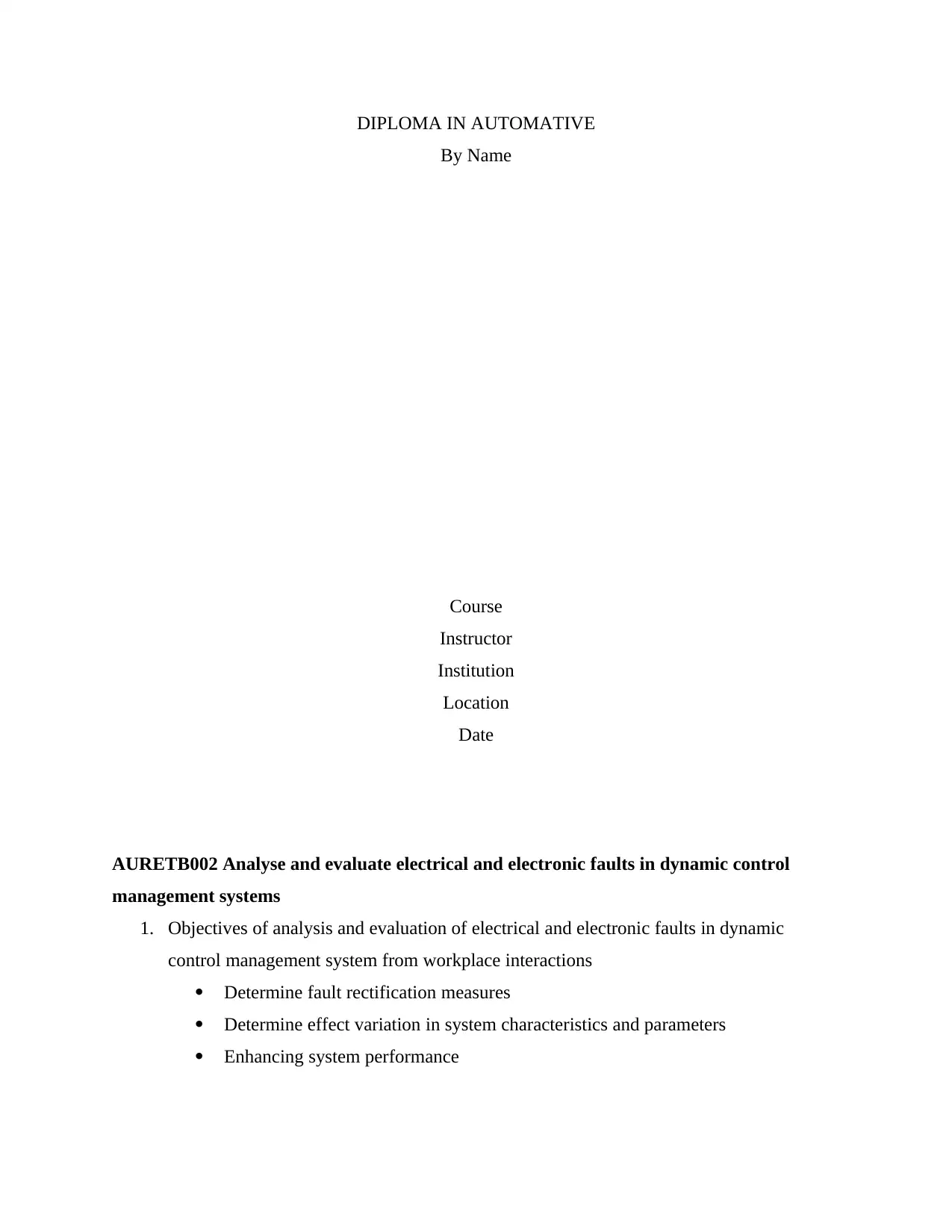
DIPLOMA IN AUTOMATIVE
By Name
Course
Instructor
Institution
Location
Date
AURETB002 Analyse and evaluate electrical and electronic faults in dynamic control
management systems
1. Objectives of analysis and evaluation of electrical and electronic faults in dynamic
control management system from workplace interactions
Determine fault rectification measures
Determine effect variation in system characteristics and parameters
Enhancing system performance
By Name
Course
Instructor
Institution
Location
Date
AURETB002 Analyse and evaluate electrical and electronic faults in dynamic control
management systems
1. Objectives of analysis and evaluation of electrical and electronic faults in dynamic
control management system from workplace interactions
Determine fault rectification measures
Determine effect variation in system characteristics and parameters
Enhancing system performance
Paraphrase This Document
Need a fresh take? Get an instant paraphrase of this document with our AI Paraphraser
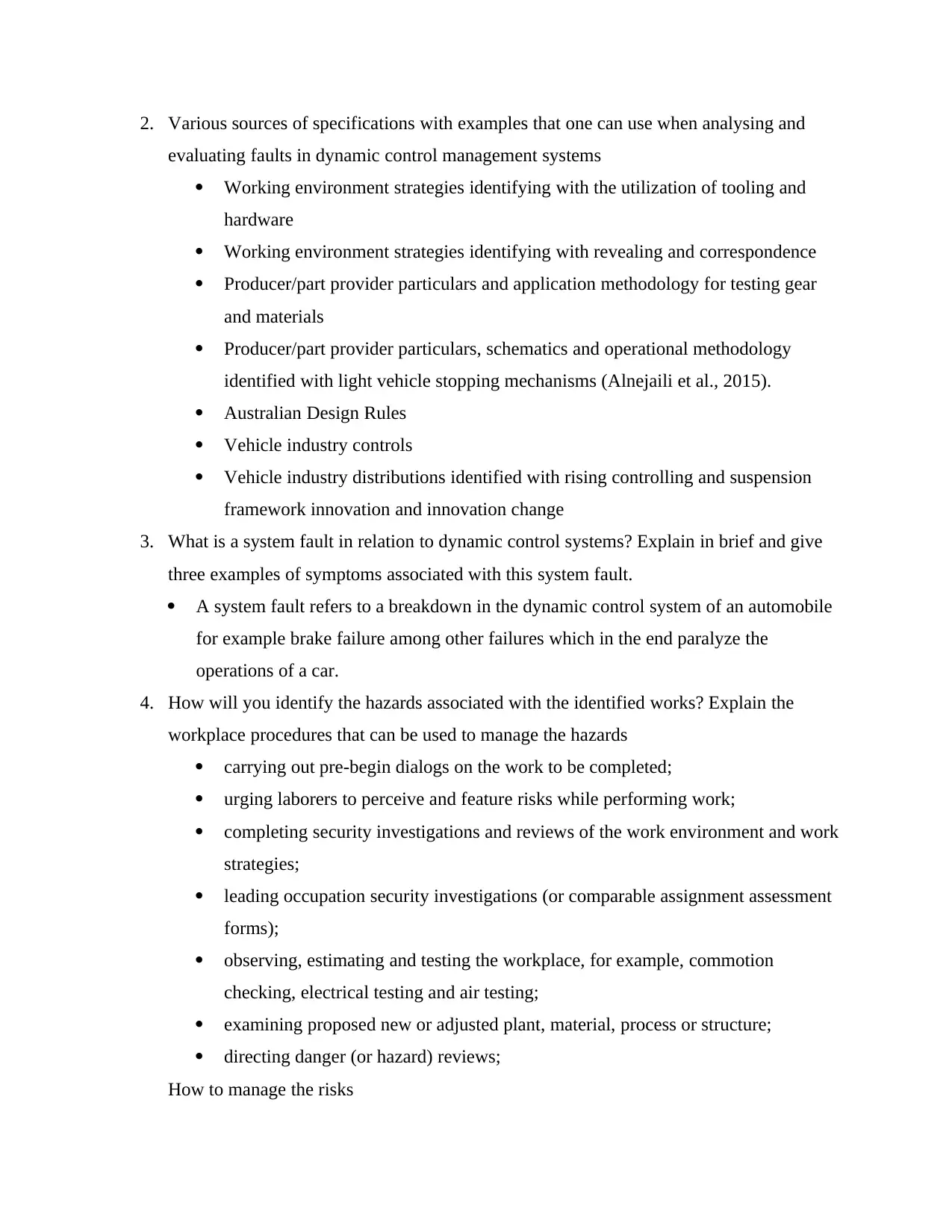
2. Various sources of specifications with examples that one can use when analysing and
evaluating faults in dynamic control management systems
Working environment strategies identifying with the utilization of tooling and
hardware
Working environment strategies identifying with revealing and correspondence
Producer/part provider particulars and application methodology for testing gear
and materials
Producer/part provider particulars, schematics and operational methodology
identified with light vehicle stopping mechanisms (Alnejaili et al., 2015).
Australian Design Rules
Vehicle industry controls
Vehicle industry distributions identified with rising controlling and suspension
framework innovation and innovation change
3. What is a system fault in relation to dynamic control systems? Explain in brief and give
three examples of symptoms associated with this system fault.
A system fault refers to a breakdown in the dynamic control system of an automobile
for example brake failure among other failures which in the end paralyze the
operations of a car.
4. How will you identify the hazards associated with the identified works? Explain the
workplace procedures that can be used to manage the hazards
carrying out pre-begin dialogs on the work to be completed;
urging laborers to perceive and feature risks while performing work;
completing security investigations and reviews of the work environment and work
strategies;
leading occupation security investigations (or comparable assignment assessment
forms);
observing, estimating and testing the workplace, for example, commotion
checking, electrical testing and air testing;
examining proposed new or adjusted plant, material, process or structure;
directing danger (or hazard) reviews;
How to manage the risks
evaluating faults in dynamic control management systems
Working environment strategies identifying with the utilization of tooling and
hardware
Working environment strategies identifying with revealing and correspondence
Producer/part provider particulars and application methodology for testing gear
and materials
Producer/part provider particulars, schematics and operational methodology
identified with light vehicle stopping mechanisms (Alnejaili et al., 2015).
Australian Design Rules
Vehicle industry controls
Vehicle industry distributions identified with rising controlling and suspension
framework innovation and innovation change
3. What is a system fault in relation to dynamic control systems? Explain in brief and give
three examples of symptoms associated with this system fault.
A system fault refers to a breakdown in the dynamic control system of an automobile
for example brake failure among other failures which in the end paralyze the
operations of a car.
4. How will you identify the hazards associated with the identified works? Explain the
workplace procedures that can be used to manage the hazards
carrying out pre-begin dialogs on the work to be completed;
urging laborers to perceive and feature risks while performing work;
completing security investigations and reviews of the work environment and work
strategies;
leading occupation security investigations (or comparable assignment assessment
forms);
observing, estimating and testing the workplace, for example, commotion
checking, electrical testing and air testing;
examining proposed new or adjusted plant, material, process or structure;
directing danger (or hazard) reviews;
How to manage the risks
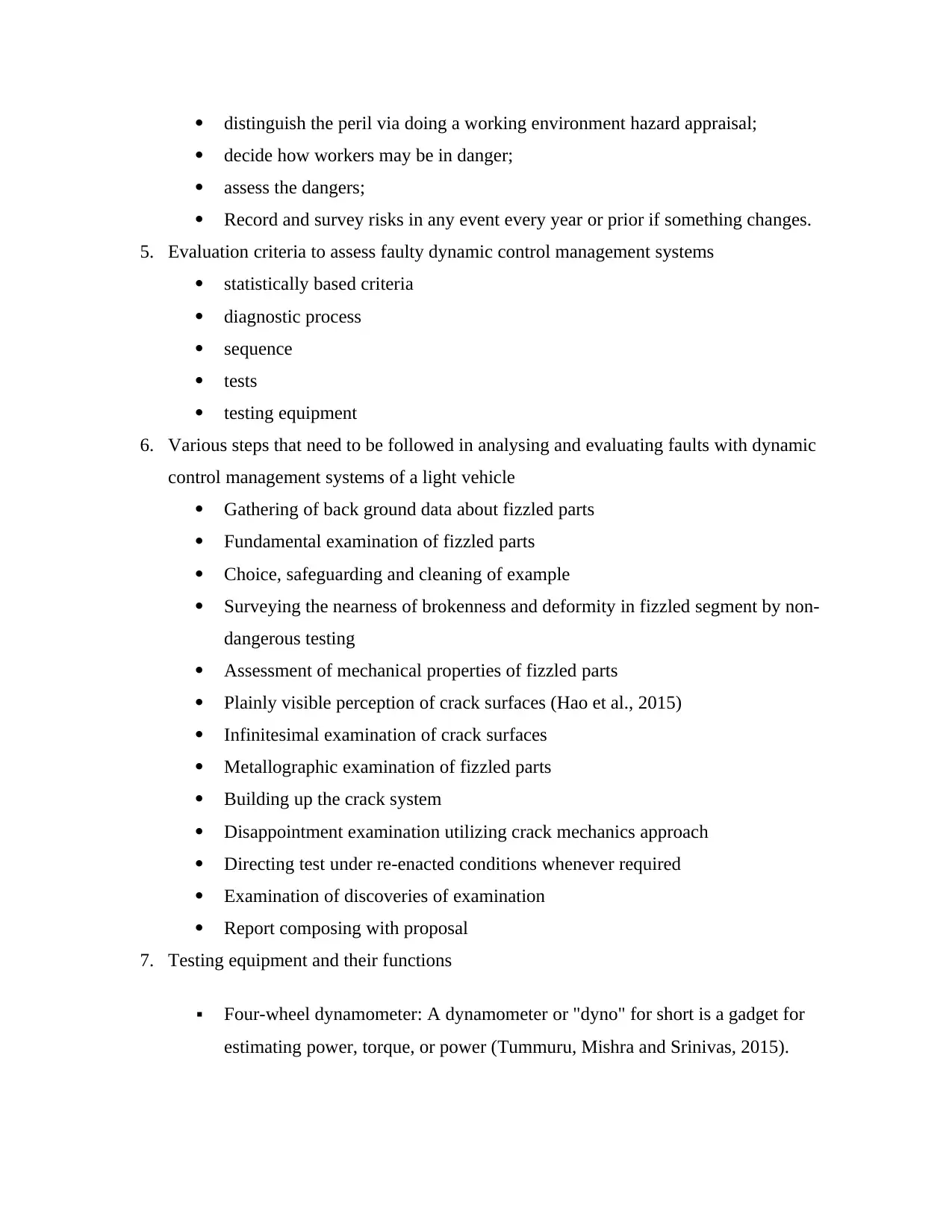
distinguish the peril via doing a working environment hazard appraisal;
decide how workers may be in danger;
assess the dangers;
Record and survey risks in any event every year or prior if something changes.
5. Evaluation criteria to assess faulty dynamic control management systems
statistically based criteria
diagnostic process
sequence
tests
testing equipment
6. Various steps that need to be followed in analysing and evaluating faults with dynamic
control management systems of a light vehicle
Gathering of back ground data about fizzled parts
Fundamental examination of fizzled parts
Choice, safeguarding and cleaning of example
Surveying the nearness of brokenness and deformity in fizzled segment by non-
dangerous testing
Assessment of mechanical properties of fizzled parts
Plainly visible perception of crack surfaces (Hao et al., 2015)
Infinitesimal examination of crack surfaces
Metallographic examination of fizzled parts
Building up the crack system
Disappointment examination utilizing crack mechanics approach
Directing test under re-enacted conditions whenever required
Examination of discoveries of examination
Report composing with proposal
7. Testing equipment and their functions
Four-wheel dynamometer: A dynamometer or "dyno" for short is a gadget for
estimating power, torque, or power (Tummuru, Mishra and Srinivas, 2015).
decide how workers may be in danger;
assess the dangers;
Record and survey risks in any event every year or prior if something changes.
5. Evaluation criteria to assess faulty dynamic control management systems
statistically based criteria
diagnostic process
sequence
tests
testing equipment
6. Various steps that need to be followed in analysing and evaluating faults with dynamic
control management systems of a light vehicle
Gathering of back ground data about fizzled parts
Fundamental examination of fizzled parts
Choice, safeguarding and cleaning of example
Surveying the nearness of brokenness and deformity in fizzled segment by non-
dangerous testing
Assessment of mechanical properties of fizzled parts
Plainly visible perception of crack surfaces (Hao et al., 2015)
Infinitesimal examination of crack surfaces
Metallographic examination of fizzled parts
Building up the crack system
Disappointment examination utilizing crack mechanics approach
Directing test under re-enacted conditions whenever required
Examination of discoveries of examination
Report composing with proposal
7. Testing equipment and their functions
Four-wheel dynamometer: A dynamometer or "dyno" for short is a gadget for
estimating power, torque, or power (Tummuru, Mishra and Srinivas, 2015).
⊘ This is a preview!⊘
Do you want full access?
Subscribe today to unlock all pages.

Trusted by 1+ million students worldwide
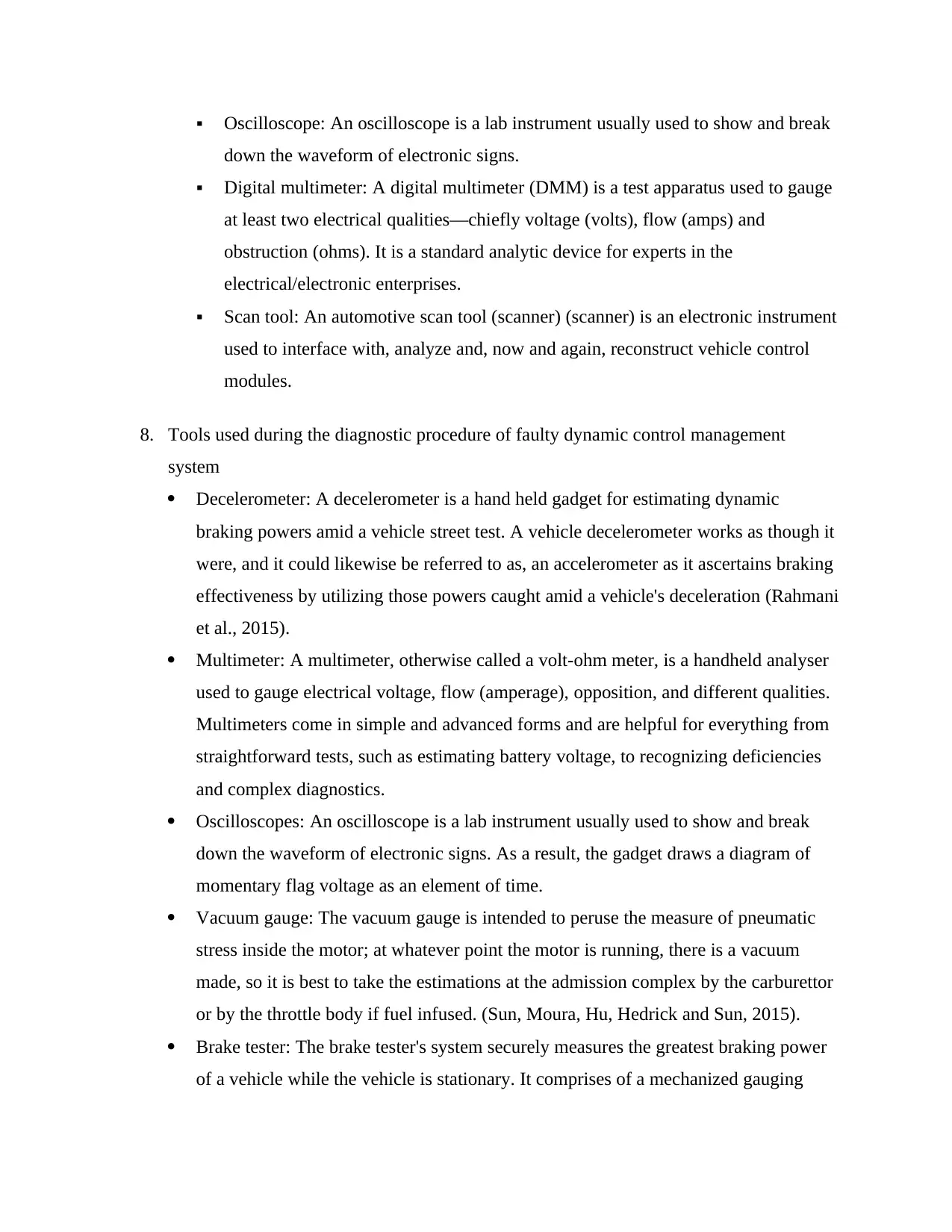
Oscilloscope: An oscilloscope is a lab instrument usually used to show and break
down the waveform of electronic signs.
Digital multimeter: A digital multimeter (DMM) is a test apparatus used to gauge
at least two electrical qualities—chiefly voltage (volts), flow (amps) and
obstruction (ohms). It is a standard analytic device for experts in the
electrical/electronic enterprises.
Scan tool: An automotive scan tool (scanner) (scanner) is an electronic instrument
used to interface with, analyze and, now and again, reconstruct vehicle control
modules.
8. Tools used during the diagnostic procedure of faulty dynamic control management
system
Decelerometer: A decelerometer is a hand held gadget for estimating dynamic
braking powers amid a vehicle street test. A vehicle decelerometer works as though it
were, and it could likewise be referred to as, an accelerometer as it ascertains braking
effectiveness by utilizing those powers caught amid a vehicle's deceleration (Rahmani
et al., 2015).
Multimeter: A multimeter, otherwise called a volt-ohm meter, is a handheld analyser
used to gauge electrical voltage, flow (amperage), opposition, and different qualities.
Multimeters come in simple and advanced forms and are helpful for everything from
straightforward tests, such as estimating battery voltage, to recognizing deficiencies
and complex diagnostics.
Oscilloscopes: An oscilloscope is a lab instrument usually used to show and break
down the waveform of electronic signs. As a result, the gadget draws a diagram of
momentary flag voltage as an element of time.
Vacuum gauge: The vacuum gauge is intended to peruse the measure of pneumatic
stress inside the motor; at whatever point the motor is running, there is a vacuum
made, so it is best to take the estimations at the admission complex by the carburettor
or by the throttle body if fuel infused. (Sun, Moura, Hu, Hedrick and Sun, 2015).
Brake tester: The brake tester's system securely measures the greatest braking power
of a vehicle while the vehicle is stationary. It comprises of a mechanized gauging
down the waveform of electronic signs.
Digital multimeter: A digital multimeter (DMM) is a test apparatus used to gauge
at least two electrical qualities—chiefly voltage (volts), flow (amps) and
obstruction (ohms). It is a standard analytic device for experts in the
electrical/electronic enterprises.
Scan tool: An automotive scan tool (scanner) (scanner) is an electronic instrument
used to interface with, analyze and, now and again, reconstruct vehicle control
modules.
8. Tools used during the diagnostic procedure of faulty dynamic control management
system
Decelerometer: A decelerometer is a hand held gadget for estimating dynamic
braking powers amid a vehicle street test. A vehicle decelerometer works as though it
were, and it could likewise be referred to as, an accelerometer as it ascertains braking
effectiveness by utilizing those powers caught amid a vehicle's deceleration (Rahmani
et al., 2015).
Multimeter: A multimeter, otherwise called a volt-ohm meter, is a handheld analyser
used to gauge electrical voltage, flow (amperage), opposition, and different qualities.
Multimeters come in simple and advanced forms and are helpful for everything from
straightforward tests, such as estimating battery voltage, to recognizing deficiencies
and complex diagnostics.
Oscilloscopes: An oscilloscope is a lab instrument usually used to show and break
down the waveform of electronic signs. As a result, the gadget draws a diagram of
momentary flag voltage as an element of time.
Vacuum gauge: The vacuum gauge is intended to peruse the measure of pneumatic
stress inside the motor; at whatever point the motor is running, there is a vacuum
made, so it is best to take the estimations at the admission complex by the carburettor
or by the throttle body if fuel infused. (Sun, Moura, Hu, Hedrick and Sun, 2015).
Brake tester: The brake tester's system securely measures the greatest braking power
of a vehicle while the vehicle is stationary. It comprises of a mechanized gauging
Paraphrase This Document
Need a fresh take? Get an instant paraphrase of this document with our AI Paraphraser
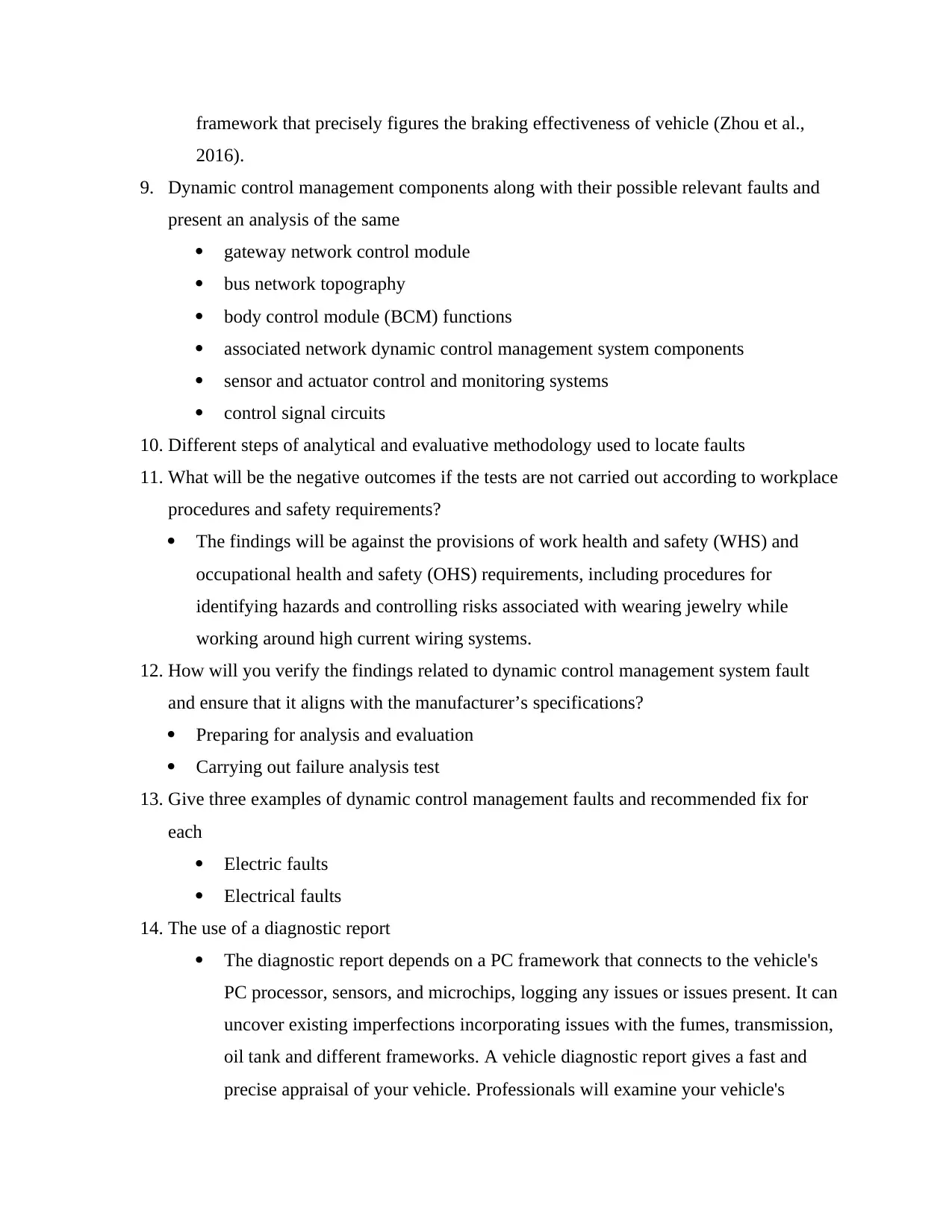
framework that precisely figures the braking effectiveness of vehicle (Zhou et al.,
2016).
9. Dynamic control management components along with their possible relevant faults and
present an analysis of the same
gateway network control module
bus network topography
body control module (BCM) functions
associated network dynamic control management system components
sensor and actuator control and monitoring systems
control signal circuits
10. Different steps of analytical and evaluative methodology used to locate faults
11. What will be the negative outcomes if the tests are not carried out according to workplace
procedures and safety requirements?
The findings will be against the provisions of work health and safety (WHS) and
occupational health and safety (OHS) requirements, including procedures for
identifying hazards and controlling risks associated with wearing jewelry while
working around high current wiring systems.
12. How will you verify the findings related to dynamic control management system fault
and ensure that it aligns with the manufacturer’s specifications?
Preparing for analysis and evaluation
Carrying out failure analysis test
13. Give three examples of dynamic control management faults and recommended fix for
each
Electric faults
Electrical faults
14. The use of a diagnostic report
The diagnostic report depends on a PC framework that connects to the vehicle's
PC processor, sensors, and microchips, logging any issues or issues present. It can
uncover existing imperfections incorporating issues with the fumes, transmission,
oil tank and different frameworks. A vehicle diagnostic report gives a fast and
precise appraisal of your vehicle. Professionals will examine your vehicle's
2016).
9. Dynamic control management components along with their possible relevant faults and
present an analysis of the same
gateway network control module
bus network topography
body control module (BCM) functions
associated network dynamic control management system components
sensor and actuator control and monitoring systems
control signal circuits
10. Different steps of analytical and evaluative methodology used to locate faults
11. What will be the negative outcomes if the tests are not carried out according to workplace
procedures and safety requirements?
The findings will be against the provisions of work health and safety (WHS) and
occupational health and safety (OHS) requirements, including procedures for
identifying hazards and controlling risks associated with wearing jewelry while
working around high current wiring systems.
12. How will you verify the findings related to dynamic control management system fault
and ensure that it aligns with the manufacturer’s specifications?
Preparing for analysis and evaluation
Carrying out failure analysis test
13. Give three examples of dynamic control management faults and recommended fix for
each
Electric faults
Electrical faults
14. The use of a diagnostic report
The diagnostic report depends on a PC framework that connects to the vehicle's
PC processor, sensors, and microchips, logging any issues or issues present. It can
uncover existing imperfections incorporating issues with the fumes, transmission,
oil tank and different frameworks. A vehicle diagnostic report gives a fast and
precise appraisal of your vehicle. Professionals will examine your vehicle's
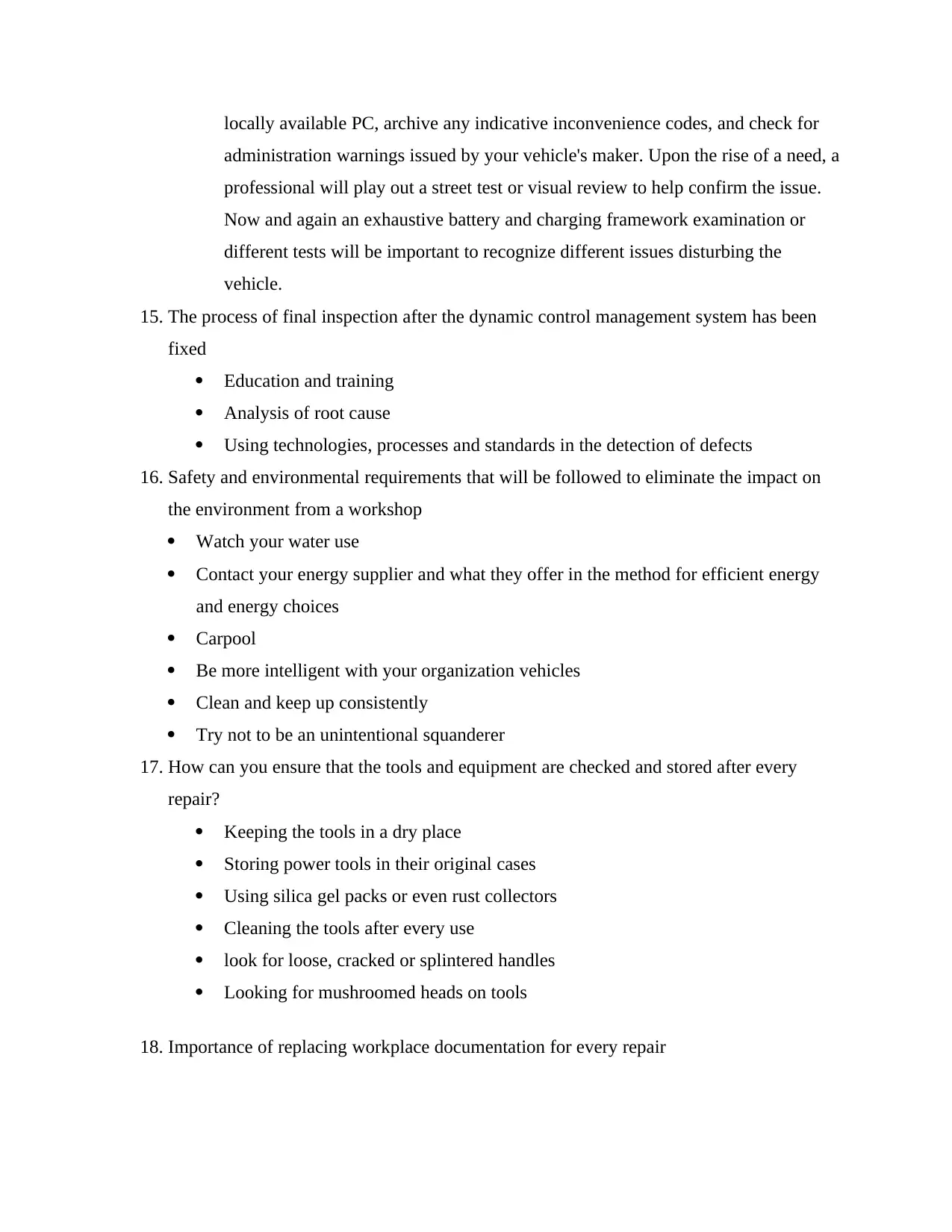
locally available PC, archive any indicative inconvenience codes, and check for
administration warnings issued by your vehicle's maker. Upon the rise of a need, a
professional will play out a street test or visual review to help confirm the issue.
Now and again an exhaustive battery and charging framework examination or
different tests will be important to recognize different issues disturbing the
vehicle.
15. The process of final inspection after the dynamic control management system has been
fixed
Education and training
Analysis of root cause
Using technologies, processes and standards in the detection of defects
16. Safety and environmental requirements that will be followed to eliminate the impact on
the environment from a workshop
Watch your water use
Contact your energy supplier and what they offer in the method for efficient energy
and energy choices
Carpool
Be more intelligent with your organization vehicles
Clean and keep up consistently
Try not to be an unintentional squanderer
17. How can you ensure that the tools and equipment are checked and stored after every
repair?
Keeping the tools in a dry place
Storing power tools in their original cases
Using silica gel packs or even rust collectors
Cleaning the tools after every use
look for loose, cracked or splintered handles
Looking for mushroomed heads on tools
18. Importance of replacing workplace documentation for every repair
administration warnings issued by your vehicle's maker. Upon the rise of a need, a
professional will play out a street test or visual review to help confirm the issue.
Now and again an exhaustive battery and charging framework examination or
different tests will be important to recognize different issues disturbing the
vehicle.
15. The process of final inspection after the dynamic control management system has been
fixed
Education and training
Analysis of root cause
Using technologies, processes and standards in the detection of defects
16. Safety and environmental requirements that will be followed to eliminate the impact on
the environment from a workshop
Watch your water use
Contact your energy supplier and what they offer in the method for efficient energy
and energy choices
Carpool
Be more intelligent with your organization vehicles
Clean and keep up consistently
Try not to be an unintentional squanderer
17. How can you ensure that the tools and equipment are checked and stored after every
repair?
Keeping the tools in a dry place
Storing power tools in their original cases
Using silica gel packs or even rust collectors
Cleaning the tools after every use
look for loose, cracked or splintered handles
Looking for mushroomed heads on tools
18. Importance of replacing workplace documentation for every repair
⊘ This is a preview!⊘
Do you want full access?
Subscribe today to unlock all pages.

Trusted by 1+ million students worldwide
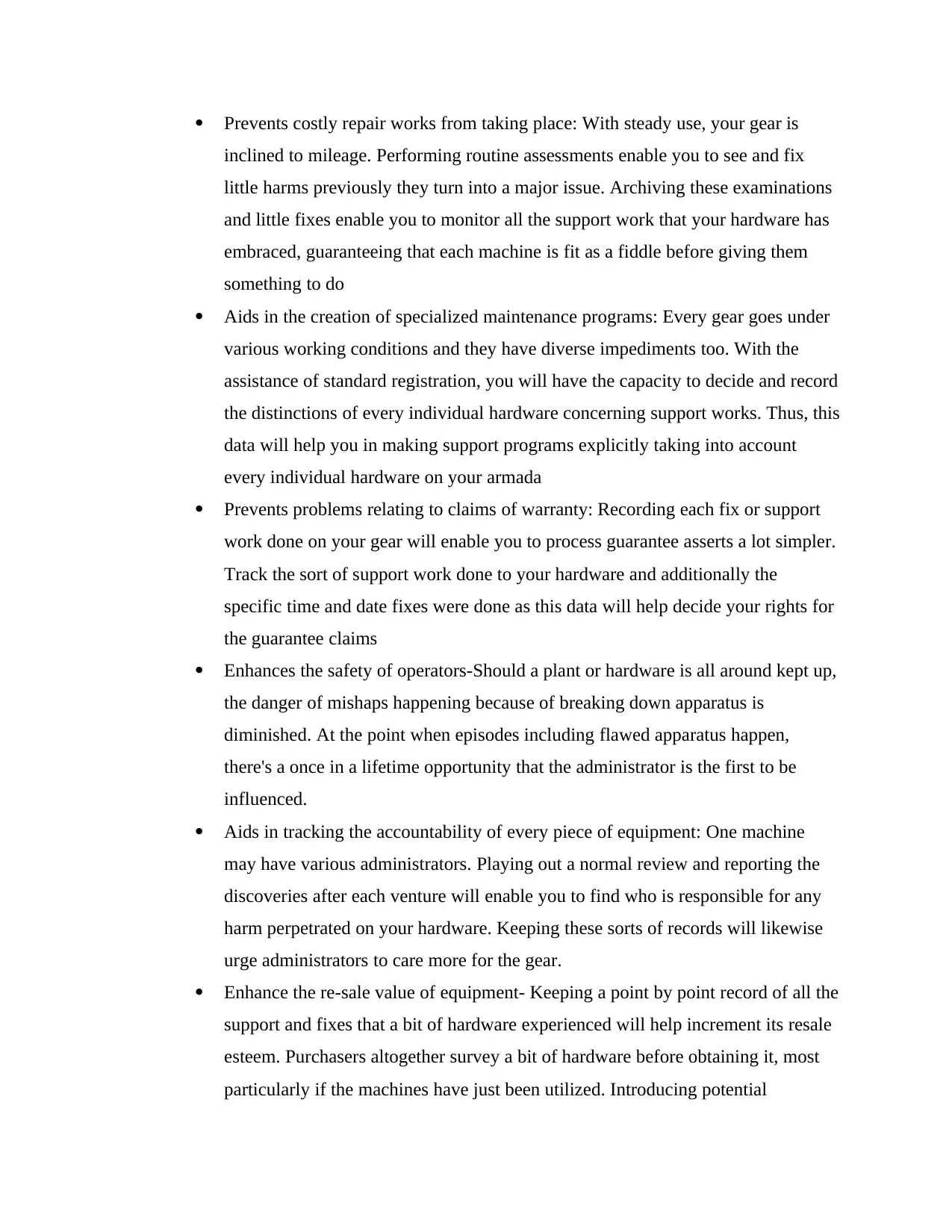
Prevents costly repair works from taking place: With steady use, your gear is
inclined to mileage. Performing routine assessments enable you to see and fix
little harms previously they turn into a major issue. Archiving these examinations
and little fixes enable you to monitor all the support work that your hardware has
embraced, guaranteeing that each machine is fit as a fiddle before giving them
something to do
Aids in the creation of specialized maintenance programs: Every gear goes under
various working conditions and they have diverse impediments too. With the
assistance of standard registration, you will have the capacity to decide and record
the distinctions of every individual hardware concerning support works. Thus, this
data will help you in making support programs explicitly taking into account
every individual hardware on your armada
Prevents problems relating to claims of warranty: Recording each fix or support
work done on your gear will enable you to process guarantee asserts a lot simpler.
Track the sort of support work done to your hardware and additionally the
specific time and date fixes were done as this data will help decide your rights for
the guarantee claims
Enhances the safety of operators-Should a plant or hardware is all around kept up,
the danger of mishaps happening because of breaking down apparatus is
diminished. At the point when episodes including flawed apparatus happen,
there's a once in a lifetime opportunity that the administrator is the first to be
influenced.
Aids in tracking the accountability of every piece of equipment: One machine
may have various administrators. Playing out a normal review and reporting the
discoveries after each venture will enable you to find who is responsible for any
harm perpetrated on your hardware. Keeping these sorts of records will likewise
urge administrators to care more for the gear.
Enhance the re-sale value of equipment- Keeping a point by point record of all the
support and fixes that a bit of hardware experienced will help increment its resale
esteem. Purchasers altogether survey a bit of hardware before obtaining it, most
particularly if the machines have just been utilized. Introducing potential
inclined to mileage. Performing routine assessments enable you to see and fix
little harms previously they turn into a major issue. Archiving these examinations
and little fixes enable you to monitor all the support work that your hardware has
embraced, guaranteeing that each machine is fit as a fiddle before giving them
something to do
Aids in the creation of specialized maintenance programs: Every gear goes under
various working conditions and they have diverse impediments too. With the
assistance of standard registration, you will have the capacity to decide and record
the distinctions of every individual hardware concerning support works. Thus, this
data will help you in making support programs explicitly taking into account
every individual hardware on your armada
Prevents problems relating to claims of warranty: Recording each fix or support
work done on your gear will enable you to process guarantee asserts a lot simpler.
Track the sort of support work done to your hardware and additionally the
specific time and date fixes were done as this data will help decide your rights for
the guarantee claims
Enhances the safety of operators-Should a plant or hardware is all around kept up,
the danger of mishaps happening because of breaking down apparatus is
diminished. At the point when episodes including flawed apparatus happen,
there's a once in a lifetime opportunity that the administrator is the first to be
influenced.
Aids in tracking the accountability of every piece of equipment: One machine
may have various administrators. Playing out a normal review and reporting the
discoveries after each venture will enable you to find who is responsible for any
harm perpetrated on your hardware. Keeping these sorts of records will likewise
urge administrators to care more for the gear.
Enhance the re-sale value of equipment- Keeping a point by point record of all the
support and fixes that a bit of hardware experienced will help increment its resale
esteem. Purchasers altogether survey a bit of hardware before obtaining it, most
particularly if the machines have just been utilized. Introducing potential
Paraphrase This Document
Need a fresh take? Get an instant paraphrase of this document with our AI Paraphraser
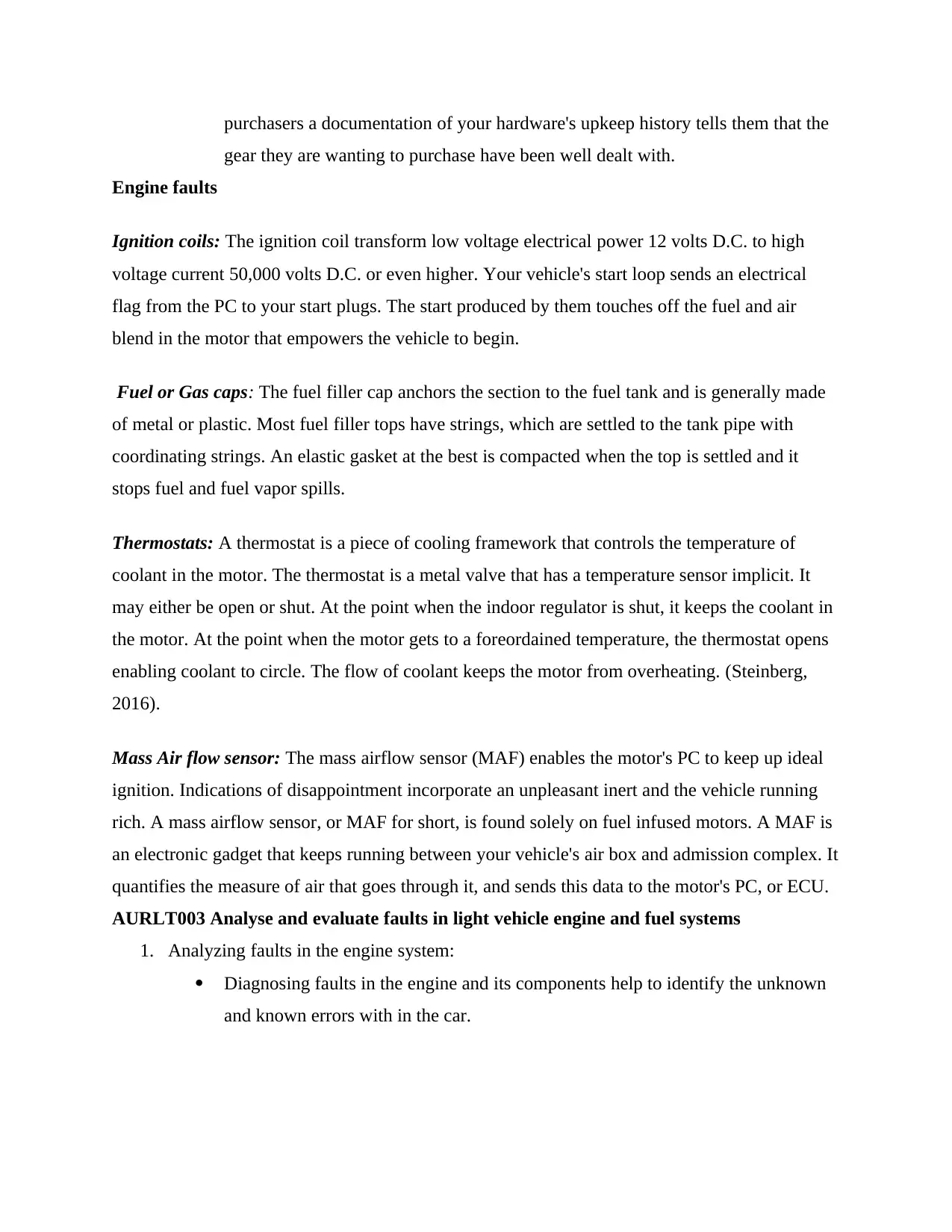
purchasers a documentation of your hardware's upkeep history tells them that the
gear they are wanting to purchase have been well dealt with.
Engine faults
Ignition coils: The ignition coil transform low voltage electrical power 12 volts D.C. to high
voltage current 50,000 volts D.C. or even higher. Your vehicle's start loop sends an electrical
flag from the PC to your start plugs. The start produced by them touches off the fuel and air
blend in the motor that empowers the vehicle to begin.
Fuel or Gas caps: The fuel filler cap anchors the section to the fuel tank and is generally made
of metal or plastic. Most fuel filler tops have strings, which are settled to the tank pipe with
coordinating strings. An elastic gasket at the best is compacted when the top is settled and it
stops fuel and fuel vapor spills.
Thermostats: A thermostat is a piece of cooling framework that controls the temperature of
coolant in the motor. The thermostat is a metal valve that has a temperature sensor implicit. It
may either be open or shut. At the point when the indoor regulator is shut, it keeps the coolant in
the motor. At the point when the motor gets to a foreordained temperature, the thermostat opens
enabling coolant to circle. The flow of coolant keeps the motor from overheating. (Steinberg,
2016).
Mass Air flow sensor: The mass airflow sensor (MAF) enables the motor's PC to keep up ideal
ignition. Indications of disappointment incorporate an unpleasant inert and the vehicle running
rich. A mass airflow sensor, or MAF for short, is found solely on fuel infused motors. A MAF is
an electronic gadget that keeps running between your vehicle's air box and admission complex. It
quantifies the measure of air that goes through it, and sends this data to the motor's PC, or ECU.
AURLT003 Analyse and evaluate faults in light vehicle engine and fuel systems
1. Analyzing faults in the engine system:
Diagnosing faults in the engine and its components help to identify the unknown
and known errors with in the car.
gear they are wanting to purchase have been well dealt with.
Engine faults
Ignition coils: The ignition coil transform low voltage electrical power 12 volts D.C. to high
voltage current 50,000 volts D.C. or even higher. Your vehicle's start loop sends an electrical
flag from the PC to your start plugs. The start produced by them touches off the fuel and air
blend in the motor that empowers the vehicle to begin.
Fuel or Gas caps: The fuel filler cap anchors the section to the fuel tank and is generally made
of metal or plastic. Most fuel filler tops have strings, which are settled to the tank pipe with
coordinating strings. An elastic gasket at the best is compacted when the top is settled and it
stops fuel and fuel vapor spills.
Thermostats: A thermostat is a piece of cooling framework that controls the temperature of
coolant in the motor. The thermostat is a metal valve that has a temperature sensor implicit. It
may either be open or shut. At the point when the indoor regulator is shut, it keeps the coolant in
the motor. At the point when the motor gets to a foreordained temperature, the thermostat opens
enabling coolant to circle. The flow of coolant keeps the motor from overheating. (Steinberg,
2016).
Mass Air flow sensor: The mass airflow sensor (MAF) enables the motor's PC to keep up ideal
ignition. Indications of disappointment incorporate an unpleasant inert and the vehicle running
rich. A mass airflow sensor, or MAF for short, is found solely on fuel infused motors. A MAF is
an electronic gadget that keeps running between your vehicle's air box and admission complex. It
quantifies the measure of air that goes through it, and sends this data to the motor's PC, or ECU.
AURLT003 Analyse and evaluate faults in light vehicle engine and fuel systems
1. Analyzing faults in the engine system:
Diagnosing faults in the engine and its components help to identify the unknown
and known errors with in the car.
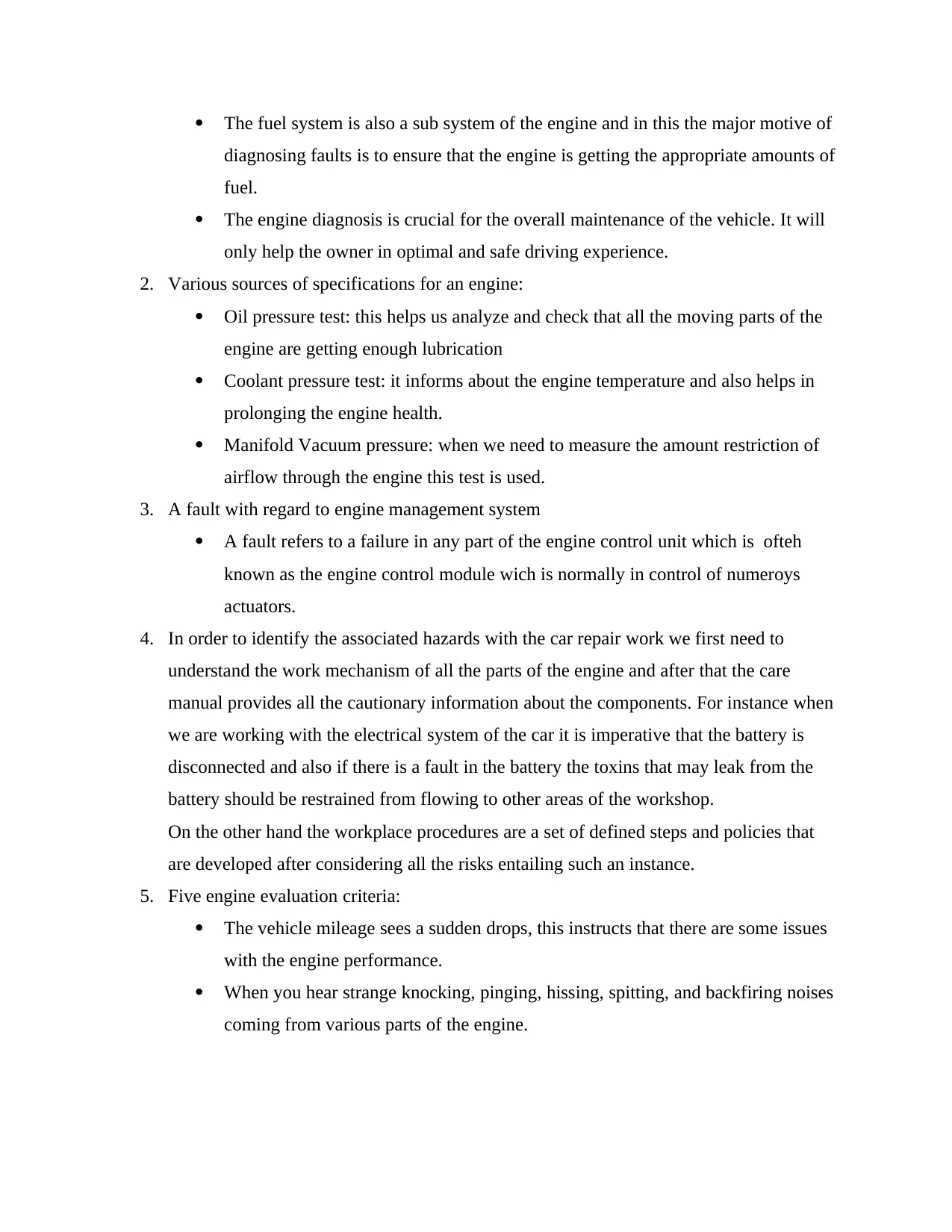
The fuel system is also a sub system of the engine and in this the major motive of
diagnosing faults is to ensure that the engine is getting the appropriate amounts of
fuel.
The engine diagnosis is crucial for the overall maintenance of the vehicle. It will
only help the owner in optimal and safe driving experience.
2. Various sources of specifications for an engine:
Oil pressure test: this helps us analyze and check that all the moving parts of the
engine are getting enough lubrication
Coolant pressure test: it informs about the engine temperature and also helps in
prolonging the engine health.
Manifold Vacuum pressure: when we need to measure the amount restriction of
airflow through the engine this test is used.
3. A fault with regard to engine management system
A fault refers to a failure in any part of the engine control unit which is ofteh
known as the engine control module wich is normally in control of numeroys
actuators.
4. In order to identify the associated hazards with the car repair work we first need to
understand the work mechanism of all the parts of the engine and after that the care
manual provides all the cautionary information about the components. For instance when
we are working with the electrical system of the car it is imperative that the battery is
disconnected and also if there is a fault in the battery the toxins that may leak from the
battery should be restrained from flowing to other areas of the workshop.
On the other hand the workplace procedures are a set of defined steps and policies that
are developed after considering all the risks entailing such an instance.
5. Five engine evaluation criteria:
The vehicle mileage sees a sudden drops, this instructs that there are some issues
with the engine performance.
When you hear strange knocking, pinging, hissing, spitting, and backfiring noises
coming from various parts of the engine.
diagnosing faults is to ensure that the engine is getting the appropriate amounts of
fuel.
The engine diagnosis is crucial for the overall maintenance of the vehicle. It will
only help the owner in optimal and safe driving experience.
2. Various sources of specifications for an engine:
Oil pressure test: this helps us analyze and check that all the moving parts of the
engine are getting enough lubrication
Coolant pressure test: it informs about the engine temperature and also helps in
prolonging the engine health.
Manifold Vacuum pressure: when we need to measure the amount restriction of
airflow through the engine this test is used.
3. A fault with regard to engine management system
A fault refers to a failure in any part of the engine control unit which is ofteh
known as the engine control module wich is normally in control of numeroys
actuators.
4. In order to identify the associated hazards with the car repair work we first need to
understand the work mechanism of all the parts of the engine and after that the care
manual provides all the cautionary information about the components. For instance when
we are working with the electrical system of the car it is imperative that the battery is
disconnected and also if there is a fault in the battery the toxins that may leak from the
battery should be restrained from flowing to other areas of the workshop.
On the other hand the workplace procedures are a set of defined steps and policies that
are developed after considering all the risks entailing such an instance.
5. Five engine evaluation criteria:
The vehicle mileage sees a sudden drops, this instructs that there are some issues
with the engine performance.
When you hear strange knocking, pinging, hissing, spitting, and backfiring noises
coming from various parts of the engine.
⊘ This is a preview!⊘
Do you want full access?
Subscribe today to unlock all pages.

Trusted by 1+ million students worldwide
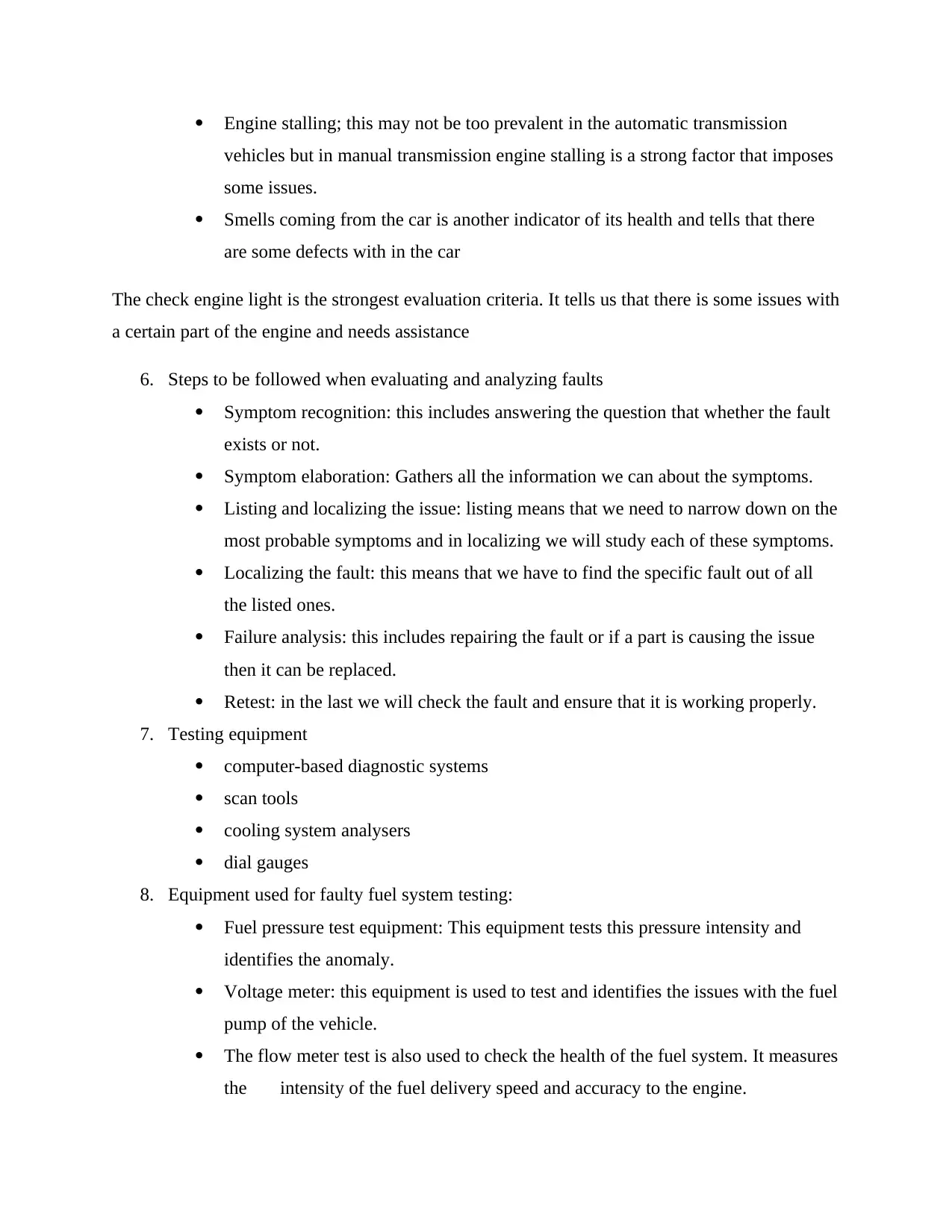
Engine stalling; this may not be too prevalent in the automatic transmission
vehicles but in manual transmission engine stalling is a strong factor that imposes
some issues.
Smells coming from the car is another indicator of its health and tells that there
are some defects with in the car
The check engine light is the strongest evaluation criteria. It tells us that there is some issues with
a certain part of the engine and needs assistance
6. Steps to be followed when evaluating and analyzing faults
Symptom recognition: this includes answering the question that whether the fault
exists or not.
Symptom elaboration: Gathers all the information we can about the symptoms.
Listing and localizing the issue: listing means that we need to narrow down on the
most probable symptoms and in localizing we will study each of these symptoms.
Localizing the fault: this means that we have to find the specific fault out of all
the listed ones.
Failure analysis: this includes repairing the fault or if a part is causing the issue
then it can be replaced.
Retest: in the last we will check the fault and ensure that it is working properly.
7. Testing equipment
computer-based diagnostic systems
scan tools
cooling system analysers
dial gauges
8. Equipment used for faulty fuel system testing:
Fuel pressure test equipment: This equipment tests this pressure intensity and
identifies the anomaly.
Voltage meter: this equipment is used to test and identifies the issues with the fuel
pump of the vehicle.
The flow meter test is also used to check the health of the fuel system. It measures
the intensity of the fuel delivery speed and accuracy to the engine.
vehicles but in manual transmission engine stalling is a strong factor that imposes
some issues.
Smells coming from the car is another indicator of its health and tells that there
are some defects with in the car
The check engine light is the strongest evaluation criteria. It tells us that there is some issues with
a certain part of the engine and needs assistance
6. Steps to be followed when evaluating and analyzing faults
Symptom recognition: this includes answering the question that whether the fault
exists or not.
Symptom elaboration: Gathers all the information we can about the symptoms.
Listing and localizing the issue: listing means that we need to narrow down on the
most probable symptoms and in localizing we will study each of these symptoms.
Localizing the fault: this means that we have to find the specific fault out of all
the listed ones.
Failure analysis: this includes repairing the fault or if a part is causing the issue
then it can be replaced.
Retest: in the last we will check the fault and ensure that it is working properly.
7. Testing equipment
computer-based diagnostic systems
scan tools
cooling system analysers
dial gauges
8. Equipment used for faulty fuel system testing:
Fuel pressure test equipment: This equipment tests this pressure intensity and
identifies the anomaly.
Voltage meter: this equipment is used to test and identifies the issues with the fuel
pump of the vehicle.
The flow meter test is also used to check the health of the fuel system. It measures
the intensity of the fuel delivery speed and accuracy to the engine.
Paraphrase This Document
Need a fresh take? Get an instant paraphrase of this document with our AI Paraphraser
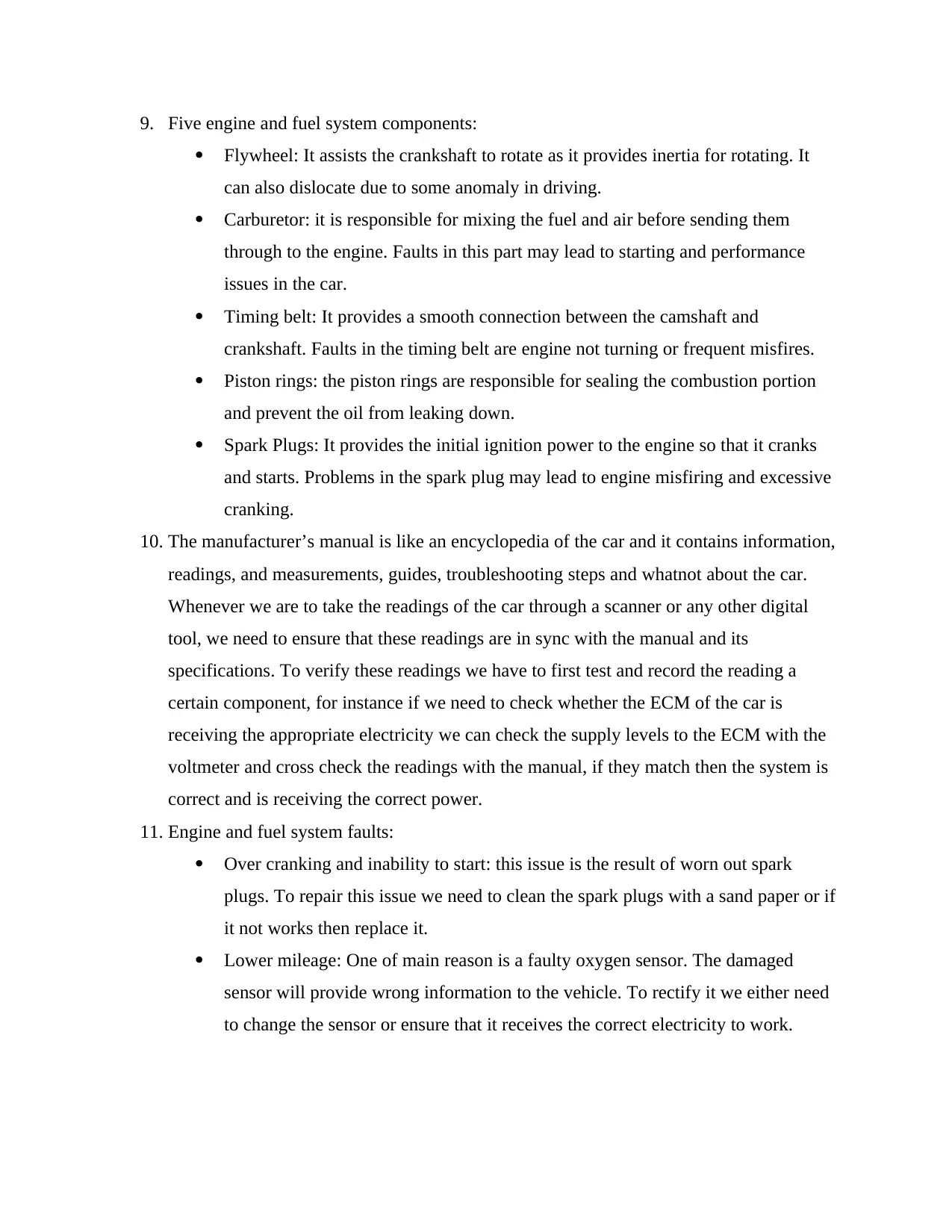
9. Five engine and fuel system components:
Flywheel: It assists the crankshaft to rotate as it provides inertia for rotating. It
can also dislocate due to some anomaly in driving.
Carburetor: it is responsible for mixing the fuel and air before sending them
through to the engine. Faults in this part may lead to starting and performance
issues in the car.
Timing belt: It provides a smooth connection between the camshaft and
crankshaft. Faults in the timing belt are engine not turning or frequent misfires.
Piston rings: the piston rings are responsible for sealing the combustion portion
and prevent the oil from leaking down.
Spark Plugs: It provides the initial ignition power to the engine so that it cranks
and starts. Problems in the spark plug may lead to engine misfiring and excessive
cranking.
10. The manufacturer’s manual is like an encyclopedia of the car and it contains information,
readings, and measurements, guides, troubleshooting steps and whatnot about the car.
Whenever we are to take the readings of the car through a scanner or any other digital
tool, we need to ensure that these readings are in sync with the manual and its
specifications. To verify these readings we have to first test and record the reading a
certain component, for instance if we need to check whether the ECM of the car is
receiving the appropriate electricity we can check the supply levels to the ECM with the
voltmeter and cross check the readings with the manual, if they match then the system is
correct and is receiving the correct power.
11. Engine and fuel system faults:
Over cranking and inability to start: this issue is the result of worn out spark
plugs. To repair this issue we need to clean the spark plugs with a sand paper or if
it not works then replace it.
Lower mileage: One of main reason is a faulty oxygen sensor. The damaged
sensor will provide wrong information to the vehicle. To rectify it we either need
to change the sensor or ensure that it receives the correct electricity to work.
Flywheel: It assists the crankshaft to rotate as it provides inertia for rotating. It
can also dislocate due to some anomaly in driving.
Carburetor: it is responsible for mixing the fuel and air before sending them
through to the engine. Faults in this part may lead to starting and performance
issues in the car.
Timing belt: It provides a smooth connection between the camshaft and
crankshaft. Faults in the timing belt are engine not turning or frequent misfires.
Piston rings: the piston rings are responsible for sealing the combustion portion
and prevent the oil from leaking down.
Spark Plugs: It provides the initial ignition power to the engine so that it cranks
and starts. Problems in the spark plug may lead to engine misfiring and excessive
cranking.
10. The manufacturer’s manual is like an encyclopedia of the car and it contains information,
readings, and measurements, guides, troubleshooting steps and whatnot about the car.
Whenever we are to take the readings of the car through a scanner or any other digital
tool, we need to ensure that these readings are in sync with the manual and its
specifications. To verify these readings we have to first test and record the reading a
certain component, for instance if we need to check whether the ECM of the car is
receiving the appropriate electricity we can check the supply levels to the ECM with the
voltmeter and cross check the readings with the manual, if they match then the system is
correct and is receiving the correct power.
11. Engine and fuel system faults:
Over cranking and inability to start: this issue is the result of worn out spark
plugs. To repair this issue we need to clean the spark plugs with a sand paper or if
it not works then replace it.
Lower mileage: One of main reason is a faulty oxygen sensor. The damaged
sensor will provide wrong information to the vehicle. To rectify it we either need
to change the sensor or ensure that it receives the correct electricity to work.
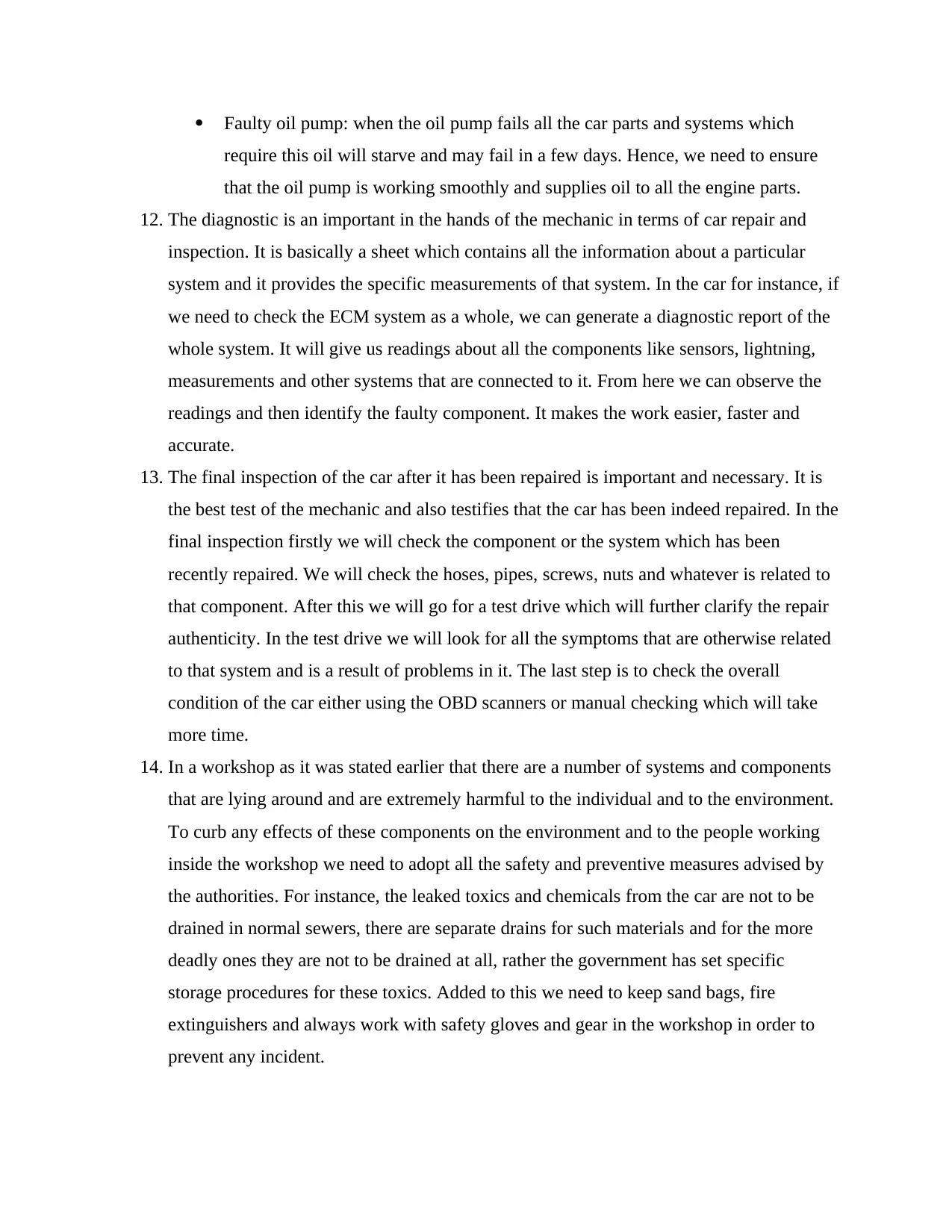
Faulty oil pump: when the oil pump fails all the car parts and systems which
require this oil will starve and may fail in a few days. Hence, we need to ensure
that the oil pump is working smoothly and supplies oil to all the engine parts.
12. The diagnostic is an important in the hands of the mechanic in terms of car repair and
inspection. It is basically a sheet which contains all the information about a particular
system and it provides the specific measurements of that system. In the car for instance, if
we need to check the ECM system as a whole, we can generate a diagnostic report of the
whole system. It will give us readings about all the components like sensors, lightning,
measurements and other systems that are connected to it. From here we can observe the
readings and then identify the faulty component. It makes the work easier, faster and
accurate.
13. The final inspection of the car after it has been repaired is important and necessary. It is
the best test of the mechanic and also testifies that the car has been indeed repaired. In the
final inspection firstly we will check the component or the system which has been
recently repaired. We will check the hoses, pipes, screws, nuts and whatever is related to
that component. After this we will go for a test drive which will further clarify the repair
authenticity. In the test drive we will look for all the symptoms that are otherwise related
to that system and is a result of problems in it. The last step is to check the overall
condition of the car either using the OBD scanners or manual checking which will take
more time.
14. In a workshop as it was stated earlier that there are a number of systems and components
that are lying around and are extremely harmful to the individual and to the environment.
To curb any effects of these components on the environment and to the people working
inside the workshop we need to adopt all the safety and preventive measures advised by
the authorities. For instance, the leaked toxics and chemicals from the car are not to be
drained in normal sewers, there are separate drains for such materials and for the more
deadly ones they are not to be drained at all, rather the government has set specific
storage procedures for these toxics. Added to this we need to keep sand bags, fire
extinguishers and always work with safety gloves and gear in the workshop in order to
prevent any incident.
require this oil will starve and may fail in a few days. Hence, we need to ensure
that the oil pump is working smoothly and supplies oil to all the engine parts.
12. The diagnostic is an important in the hands of the mechanic in terms of car repair and
inspection. It is basically a sheet which contains all the information about a particular
system and it provides the specific measurements of that system. In the car for instance, if
we need to check the ECM system as a whole, we can generate a diagnostic report of the
whole system. It will give us readings about all the components like sensors, lightning,
measurements and other systems that are connected to it. From here we can observe the
readings and then identify the faulty component. It makes the work easier, faster and
accurate.
13. The final inspection of the car after it has been repaired is important and necessary. It is
the best test of the mechanic and also testifies that the car has been indeed repaired. In the
final inspection firstly we will check the component or the system which has been
recently repaired. We will check the hoses, pipes, screws, nuts and whatever is related to
that component. After this we will go for a test drive which will further clarify the repair
authenticity. In the test drive we will look for all the symptoms that are otherwise related
to that system and is a result of problems in it. The last step is to check the overall
condition of the car either using the OBD scanners or manual checking which will take
more time.
14. In a workshop as it was stated earlier that there are a number of systems and components
that are lying around and are extremely harmful to the individual and to the environment.
To curb any effects of these components on the environment and to the people working
inside the workshop we need to adopt all the safety and preventive measures advised by
the authorities. For instance, the leaked toxics and chemicals from the car are not to be
drained in normal sewers, there are separate drains for such materials and for the more
deadly ones they are not to be drained at all, rather the government has set specific
storage procedures for these toxics. Added to this we need to keep sand bags, fire
extinguishers and always work with safety gloves and gear in the workshop in order to
prevent any incident.
⊘ This is a preview!⊘
Do you want full access?
Subscribe today to unlock all pages.

Trusted by 1+ million students worldwide
1 out of 25
Related Documents
Your All-in-One AI-Powered Toolkit for Academic Success.
+13062052269
info@desklib.com
Available 24*7 on WhatsApp / Email
![[object Object]](/_next/static/media/star-bottom.7253800d.svg)
Unlock your academic potential
Copyright © 2020–2025 A2Z Services. All Rights Reserved. Developed and managed by ZUCOL.





